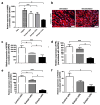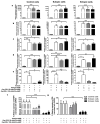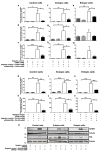Membrane Progesterone Receptor Beta Regulates the Decidualization of Endometrial Stromal Cells in Women with Endometriosis
- PMID: 40806428
- PMCID: PMC12347855
- DOI: 10.3390/ijms26157297
Membrane Progesterone Receptor Beta Regulates the Decidualization of Endometrial Stromal Cells in Women with Endometriosis
Abstract
Endometriosis is a disorder characterized by the presence of endometrial tissue outside the uterus, leading to dyspareunia, chronic pelvic pain, dysuria, and infertility. The latter has been related to implantation failure associated with alterations in decidualization, a process regulated by sex hormones such as progesterone. Membrane progesterone receptor β (mPRβ) exhibits a lower expression in endometriotic tissues than in normal endometrial ones. However, the role of mPRβ in decidualization is unknown. This work aimed to investigate whether mPRβ plays a role in the decidualization of endometrial stromal cells (ESCs) derived from women with and without endometriosis. The mPR agonist OrgOD-2 induced the gene expression of key decidualization markers (insulin-like growth factor binding protein 1, prolactin, transcription factor heart and neural crest derivatives-expressed transcript 2, and fork-head transcription factor) in healthy ESCs, eutopic (uterine cavity), and ectopic (outside of the uterine cavity) ESCs from women with endometriosis. Notably, the expression of the decidualization markers was lower in endometriotic cells than in healthy endometrial ones. An siRNA mediated knockdown of mPRβ reduced the expression of decidualization-associated genes in ESCs treated with a decidualization stimuli, regardless of whether cells were derived from healthy women or those with endometriosis. Our data suggest that progesterone, through mPRβ activation, regulates the decidualization process in endometrial stromal cells from women with and without endometriosis.
Keywords: decidualization; endometrial stromal cells; endometriosis; membrane progesterone receptors; progesterone.
Conflict of interest statement
The authors declare no conflicts of interest.
Figures




Similar articles
-
Diet-induced obesity impairs endometrial stromal cell decidualization: a potential role for impaired autophagy.Hum Reprod. 2016 Jun;31(6):1315-26. doi: 10.1093/humrep/dew048. Epub 2016 Apr 6. Hum Reprod. 2016. PMID: 27052498 Free PMC article.
-
The SARS-CoV-2 receptor, Angiotensin converting enzyme 2 (ACE2) is required for human endometrial stromal cell decidualization.bioRxiv [Preprint]. 2020 Jun 24:2020.06.23.168252. doi: 10.1101/2020.06.23.168252. bioRxiv. 2020. Update in: Biol Reprod. 2021 Feb 11;104(2):336-343. doi: 10.1093/biolre/ioaa211. PMID: 32607509 Free PMC article. Updated. Preprint.
-
Progesterone receptor modulators for endometriosis.Cochrane Database Syst Rev. 2017 Jul 25;7(7):CD009881. doi: 10.1002/14651858.CD009881.pub2. Cochrane Database Syst Rev. 2017. PMID: 28742263 Free PMC article.
-
Unveiling the molecular mechanisms of human platelet lysate in enhancing endometrial receptivity.Hum Reprod. 2025 Jul 15:deaf118. doi: 10.1093/humrep/deaf118. Online ahead of print. Hum Reprod. 2025. PMID: 40663777
-
Mechanisms of Decidual Dysfunction and Infertility in Endometriosis: Roles of Prostaglandins and SASP.Reprod Med Biol. 2025 Jun 19;24(1):e12663. doi: 10.1002/rmb2.12663. eCollection 2025 Jan-Dec. Reprod Med Biol. 2025. PMID: 40538816 Free PMC article. Review.
References
Grants and funding
LinkOut - more resources
Full Text Sources
Research Materials

